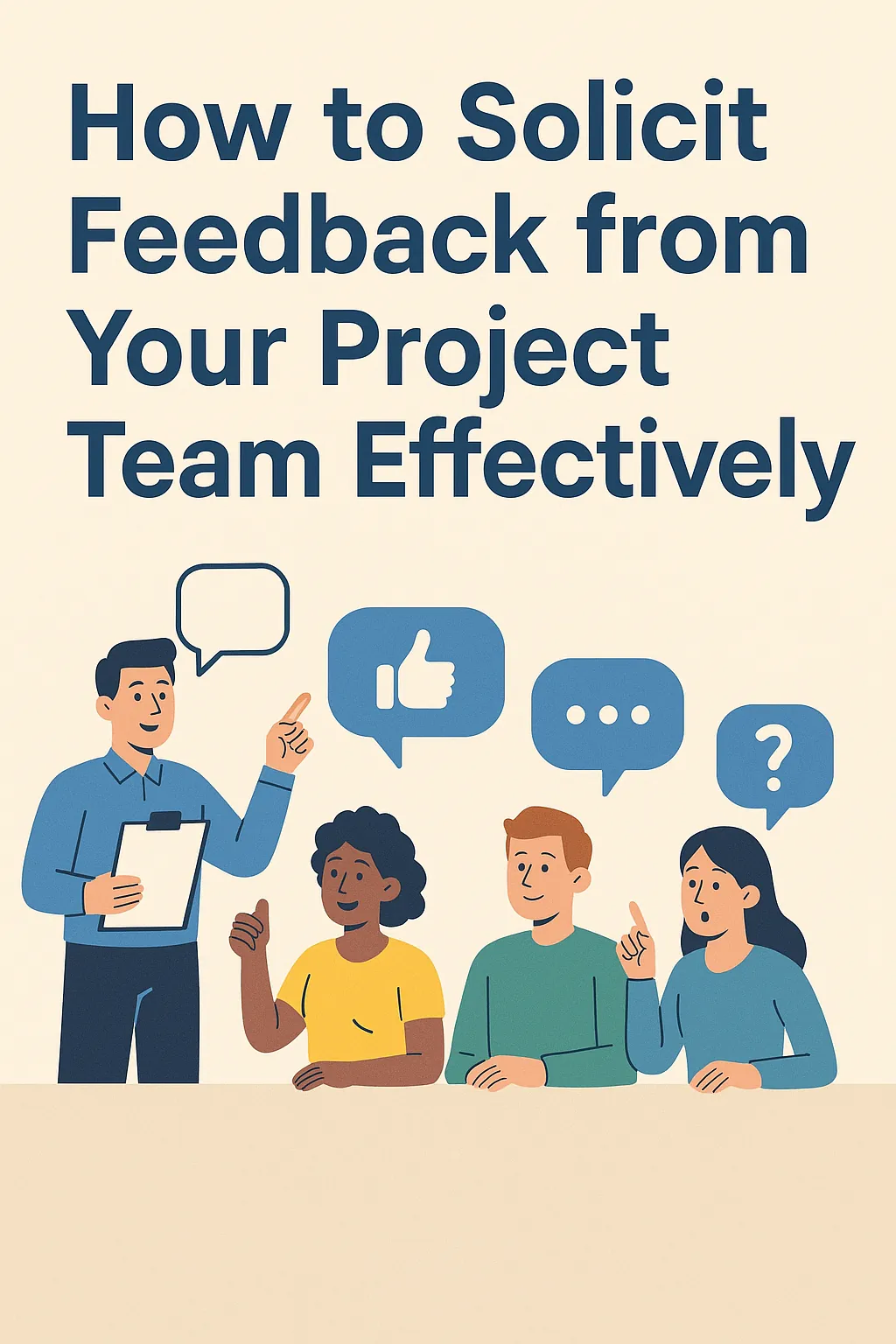Introduction
Feedback serves as a vital component that can significantly influence the trajectory of a project. Feedback, in this context, refers to the information provided by team members regarding their experiences, challenges, and suggestions related to the project. It encompasses both positive reinforcement and constructive criticism, allowing project managers to gauge the effectiveness of their strategies and the overall team dynamics [2][14].
Soliciting feedback is essential for project success for several reasons:
- Enhances Team Performance: Regular feedback helps identify areas for improvement, enabling team members to refine their skills and enhance their contributions to the project [2][13].
- Aligns Objectives: Gathering insights from the team ensures that everyone is on the same page regarding project goals and expectations, fostering a sense of ownership and accountability [12][13].
- Promotes Open Communication: Encouraging feedback creates an environment where team members feel valued and heard, which can lead to increased morale and collaboration [11][14].
However, project managers often face challenges when seeking feedback. These can include:
- Reluctance to Share: Team members may hesitate to provide honest feedback due to fear of repercussions or a lack of trust in the process [11].
- Time Constraints: Busy schedules can make it difficult for project managers to find the time to solicit and process feedback effectively [4][5].
- Miscommunication: Without clear guidelines on how to provide feedback, team members may struggle to articulate their thoughts, leading to misunderstandings [10][12].
By understanding the importance of feedback and the challenges associated with it, project managers can develop effective strategies to foster open communication within their teams, ultimately driving project success.
Understanding the Importance of Feedback
Feedback is a vital component of effective project management, serving as a bridge between project managers and their teams. It not only enhances communication but also plays a crucial role in fostering a positive work environment. Here are some key points highlighting the benefits of feedback for both project managers and their teams:
- Fostering a Culture of Open Communication: Encouraging feedback creates an atmosphere where team members feel comfortable sharing their thoughts and opinions. This openness is essential for building trust and collaboration within the team. When project managers actively solicit feedback, they demonstrate that they value their team members’ insights, which can lead to more candid discussions and innovative ideas. This culture of communication helps to break down barriers and encourages a more engaged and cohesive team dynamic [10][15].
- Impact on Team Morale and Productivity: Constructive feedback can significantly boost team morale. When team members receive recognition for their contributions, it reinforces their sense of purpose and belonging within the project. Positive feedback highlights what is working well, while constructive criticism provides opportunities for growth. This balance can lead to increased motivation and productivity, as team members are more likely to feel invested in their work and strive for excellence [2][11]. Moreover, timely and specific feedback helps individuals understand their roles better, leading to improved performance and efficiency [4].
- Continuous Improvement and Project Success: Feedback is essential for continuous improvement within project teams. By regularly gathering input from team members, project managers can identify areas for enhancement and implement necessary changes. This iterative approach not only helps in refining processes but also ensures that the project aligns with stakeholder expectations. Furthermore, conducting post-project reviews allows teams to evaluate outcomes and learn from both successes and challenges, ultimately contributing to future project success [9][12]. The commitment to integrating feedback into every phase of a project enhances adaptability and responsiveness, which are critical in today’s fast-paced project environments [12].
Creating a Safe Environment for Feedback
Fostering a trusting atmosphere for feedback is essential for project managers and team facilitators aiming to enhance communication and collaboration within their teams. Here are several strategies to create a safe environment for feedback:
- Encourage Psychological Safety: It is crucial to cultivate an environment where team members feel safe to express their thoughts and opinions without fear of negative consequences. This can be achieved by actively listening to team members, validating their contributions, and ensuring that all voices are heard during discussions. When team members believe that their input is valued, they are more likely to share honest feedback, which can lead to improved project outcomes [2][10].
- Implement Ground Rules for Feedback: Establishing clear guidelines for giving and receiving feedback can help create a structured and respectful environment. These ground rules should emphasize constructive criticism, focusing on behaviors rather than personal attributes, and encourage team members to provide specific examples when giving feedback. By setting these expectations, project managers can help ensure that feedback sessions remain productive and focused on improvement rather than becoming confrontational [11][15].
- Share Personal Experiences: Demonstrating vulnerability by sharing personal experiences related to feedback can significantly enhance trust within the team. When project managers openly discuss their own challenges and how they have learned from feedback, it encourages team members to do the same. This practice not only humanizes the feedback process but also reinforces the idea that everyone, including leaders, is on a continuous journey of growth and development [1][2].
By implementing these strategies, project managers can create a safe and supportive environment that encourages open communication and fosters a culture of continuous improvement within their teams. This approach not only enhances team dynamics but also contributes to the overall success of projects.
Choosing the Right Feedback Channels
Effective feedback is crucial for project managers to ensure that their teams are aligned, engaged, and performing at their best. Selecting the right channels for soliciting feedback can significantly enhance communication and foster a culture of openness. Here are some strategies to consider:
Differentiate Between Formal and Informal Feedback Channels
- Formal Feedback Channels: These include structured methods such as performance reviews, surveys, and questionnaires. They provide a systematic approach to gather insights and can be particularly useful for assessing team members’ performance against set objectives. For instance, structured surveys can help gather specific feedback from stakeholders and team members about project progress and areas for improvement [12].
- Informal Feedback Channels: These are more spontaneous and can occur in casual settings, such as during team lunches or informal check-ins. Informal feedback encourages open dialogue and can lead to more candid responses, as team members may feel less pressure compared to formal settings. This type of feedback can be vital for understanding team dynamics and morale [10].
The Role of One-on-One Meetings, Surveys, and Team Retrospectives
- One-on-One Meetings: Regular individual meetings between project managers and team members create a safe space for open communication. These sessions allow for personalized feedback and can help address specific concerns or suggestions that may not come up in group settings. They are essential for building trust and rapport within the team [9].
- Surveys: Utilizing surveys can streamline the feedback process, especially for larger teams. They can be designed to gather quantitative data on team performance and satisfaction, allowing project managers to identify trends and areas needing attention. Surveys can be particularly effective when they are anonymous, as this encourages more honest feedback [12].
- Team Retrospectives: Conducting retrospectives at the end of a project or sprint provides an opportunity for the entire team to reflect on what went well and what could be improved. This collective feedback fosters a sense of ownership and accountability among team members, as they collaboratively identify solutions to enhance future performance [11].
Importance of Utilizing Digital Tools for Remote Teams
In today’s increasingly remote work environment, leveraging digital tools is essential for effective feedback solicitation. Tools like Trello, Asana, or Jira not only facilitate project management but also include features for commenting and providing feedback directly on tasks. This contextual feedback helps keep discussions relevant and focused on specific issues [9].
Additionally, video conferencing tools can enhance one-on-one meetings and team retrospectives, ensuring that all team members, regardless of location, can participate actively. By integrating these digital solutions, project managers can maintain open lines of communication and ensure that feedback is both timely and actionable [8].
Timing and Frequency of Feedback Requests
Soliciting feedback from your project team is a crucial aspect of effective project management. The timing and frequency of these requests can significantly influence the quality and usefulness of the feedback received. Here are some strategies to consider:
- Identify Key Project Milestones: It is essential to pinpoint specific milestones within the project timeline where feedback can be most beneficial. These milestones serve as natural checkpoints to assess progress and gather insights from team members. By aligning feedback requests with these critical moments, project managers can ensure that the feedback is relevant and timely, allowing for adjustments to be made as needed [1].
- Encourage Continuous Feedback: Rather than waiting for formal review periods, project managers should foster an environment where continuous feedback is encouraged. This approach allows team members to share their thoughts and concerns in real-time, leading to quicker resolutions and improvements. Continuous feedback helps in identifying issues early on, which can prevent larger problems from developing later in the project lifecycle [1][13].
- Advantages of Regular Check-Ins and Pulse Surveys: Implementing regular check-ins, such as weekly meetings or informal catch-ups, can create a routine for feedback solicitation. These sessions provide a platform for team members to voice their opinions and experiences, enhancing communication and collaboration. Additionally, pulse surveys can be an effective tool for gathering feedback quickly and efficiently. By making these surveys easily accessible, project managers can encourage participation and obtain reliable results that inform decision-making [8][10].
Crafting Effective Feedback Questions
Soliciting feedback from your project team is essential for fostering an environment of open communication and continuous improvement. As a project manager, the way you frame your questions can significantly influence the quality of the feedback you receive. Here are some strategies to help you craft effective feedback questions.
Understanding Open-Ended vs. Closed Questions
Open-Ended Questions: These questions encourage detailed responses and allow team members to express their thoughts freely. They typically begin with words like “how,” “what,” or “why.” For example:
- “What challenges did you face during this project phase?”
- “How do you think we can improve our communication?”
Closed Questions: These questions can be answered with a simple “yes” or “no,” or a specific piece of information. They are useful for gathering straightforward data but may limit the depth of feedback. For example:
- “Did you find the project timeline realistic?”
- “Was the training session helpful?”
Examples of Effective Feedback Questions
To elicit constructive feedback, consider tailoring your questions to specific scenarios:
- Project Progress: “What aspects of the project do you feel are on track, and which areas need more attention?”
- Team Collaboration: “How well do you think our team is collaborating? What could enhance our teamwork?”
- Resource Allocation: “Do you feel you have the necessary resources to complete your tasks effectively? If not, what is missing?”
- Post-Project Review: “Looking back at the project, what do you think worked well, and what would you change if we were to do it again?”
Framing Questions to Avoid Leading Responses
To ensure that your questions do not lead to biased or predetermined answers, consider the following tips:
- Be Neutral: Avoid using language that suggests a preferred answer. For instance, instead of asking, “How much did you enjoy the new project management tool?” ask, “What are your thoughts on the new project management tool?”
- Encourage Honesty: Frame questions in a way that reassures team members that their honest feedback is valued. For example, “What concerns do you have about our current project approach?” invites candid responses without implying negativity.
- Focus on Specifics: Instead of asking broad questions that may confuse respondents, direct them towards specific aspects of the project. For example, “What specific features of the project management software do you find most useful?” is more effective than “What do you think about the software?”
By employing these strategies, project managers can create a feedback-rich environment that not only enhances team performance but also fosters a culture of open communication and continuous improvement. This approach ultimately leads to better project outcomes and a more engaged team.
Acting on Feedback
Soliciting feedback from your team is just the first step; acting on that feedback is crucial for fostering an environment of trust and collaboration. Here are some key points to consider when responding to feedback from your project team:
Acknowledging Received Feedback
- Importance of Recognition: Project managers must acknowledge the feedback they receive to validate the team members’ contributions. This recognition not only shows that their opinions are valued but also encourages further communication. When team members see that their feedback leads to discussions or changes, they are more likely to share their thoughts in the future [2][12].
- Creating a Feedback Loop: Establishing a continuous feedback loop is essential. This means not only collecting feedback but also communicating back to the team about how their input is being used. This transparency builds trust and reinforces the idea that their voices matter [11][14].
Prioritizing and Implementing Actionable Feedback
- Assessing Feedback: Not all feedback will be equally actionable or relevant. Project managers should prioritize feedback based on its potential impact on project goals and team dynamics. This involves evaluating which suggestions align with the project’s objectives and can lead to meaningful improvements [4][14].
- Creating an Action Plan: Once feedback is prioritized, project managers should develop a clear action plan. This plan should outline specific steps to implement the feedback, assign responsibilities, and set timelines for completion. By doing so, project managers can ensure that feedback is not just acknowledged but actively integrated into the project workflow [3][10].
Examples of Successful Changes Based on Team Feedback
- Case Study of Improved Communication: For instance, a project team may have expressed concerns about communication gaps during meetings. In response, the project manager could implement a structured agenda for meetings and introduce regular check-ins. This change not only addressed the feedback but also enhanced overall team collaboration and efficiency [1][12].
- Adapting Tools and Processes: Another example could involve feedback regarding the use of project management tools. If team members find a particular tool cumbersome, the project manager might explore alternatives or provide additional training. Such adjustments can lead to increased productivity and a more engaged team [10][14].
Measuring the Impact of Feedback
Soliciting feedback from your team is not just a formality; it is a critical component that can significantly influence team performance and project outcomes. To ensure that your feedback processes are effective, it is essential to measure their impact systematically. Here are some strategies to help project managers assess the effectiveness of their feedback mechanisms:
Methods for Evaluating Feedback Impact on Team Performance
- Performance Metrics: Regularly review quantitative metrics related to project performance, such as completion rates, quality of deliverables, and adherence to timelines. These metrics can provide insights into how feedback has influenced team productivity and project success. By correlating performance data with feedback sessions, project managers can identify trends and areas for improvement [3][11].
- Post-Project Reviews: Conducting thorough post-project evaluations allows project managers to assess the overall effectiveness of feedback provided throughout the project lifecycle. This process involves gathering insights from team members about what feedback was helpful and what could be improved. It also helps in identifying best practices for future projects [9][10].
The Role of Follow-Up Surveys and Team Discussions
- Follow-Up Surveys: Implementing structured surveys after feedback sessions can help gauge team members’ perceptions of the feedback they received. Questions can focus on clarity, relevance, and the perceived impact of the feedback on their work. This data can be invaluable in understanding how feedback is received and its effectiveness in driving performance [15].
- Team Discussions: Facilitating open discussions within the team about the feedback process can foster a culture of transparency and continuous improvement. These discussions can provide qualitative insights into how team members feel about the feedback they receive and how it affects their motivation and performance. Encouraging team members to share their thoughts can lead to more constructive feedback practices [10][14].
Adjusting Feedback Strategies Based on Evaluation Results
- Iterative Improvement: Based on the insights gathered from performance metrics, surveys, and discussions, project managers should be prepared to adjust their feedback strategies. This may involve changing the frequency of feedback sessions, the methods used to deliver feedback, or the focus areas of the feedback itself. Adapting feedback strategies ensures that they remain relevant and effective in meeting the team’s needs [5][12].
- Personalization of Feedback: Recognizing that each team member may respond differently to feedback is crucial. Tailoring feedback approaches to individual preferences and work styles can enhance its effectiveness. Project managers should consider the feedback received from team members about their experiences and adjust their methods accordingly [12][13].
By implementing these strategies, project managers can create a robust feedback process that not only enhances team performance but also fosters a culture of open communication and continuous improvement. This proactive approach to measuring and adjusting feedback will ultimately lead to more successful project outcomes and a more engaged team.
Conclusion
Soliciting feedback from your project team is not just a beneficial practice; it is essential for ensuring project success. Effective feedback mechanisms foster an environment of open communication, allowing team members to express their thoughts and concerns, which ultimately leads to improved project outcomes. By actively seeking input, project managers can gain valuable insights that help identify areas for improvement and enhance overall team performance [2][9].
To implement these strategies effectively, project managers should consider the following approaches:
- Establish Clear Communication Channels: Create structured opportunities for feedback, such as regular check-ins and one-on-one meetings, to ensure that team members feel comfortable sharing their thoughts [12][10].
- Utilize Feedback Tools: Leverage project management tools that facilitate real-time feedback, keeping discussions contextual and relevant to ongoing tasks [10][3].
- Encourage a Culture of Openness: Model the behavior you wish to see by being receptive to feedback yourself. This sets a precedent for team members to follow [6][11].
As you reflect on these strategies, consider how you can integrate them into your project management practices. The goal is to create a feedback-rich environment that not only drives project success but also nurtures team growth and collaboration.
Find out more about Shaun Stoltz https://www.shaunstoltz.com/about/.
This post was written by an AI and reviewed/edited by a human.



